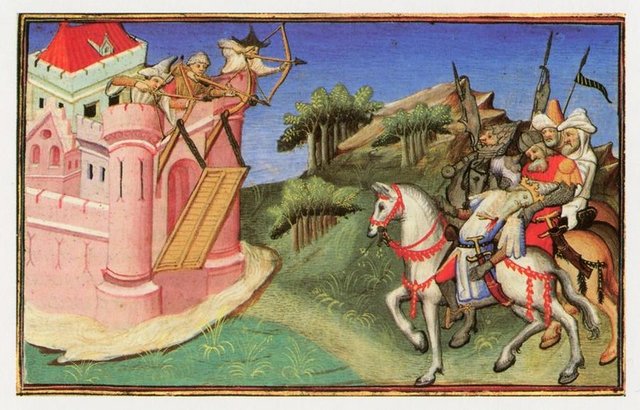HBC: The Tatar-Mongolian yoke-ke
I am interested in the process of finding a certain truth in history. And in principle, the result is not important. Although I write mostly about the results that I like.
Once the Mongols captured half of the inhabited world and created a great empire. And where are they now? Have you ever seen a Mongol? Even in Mongolia, where there are less than one Mongolian per square kilometer, not every Mongol saw a Mongol.
Not so long ago, he made a repost on the myth of the Tatar-Mongolian yoke and received in the comments reproaches in "militant ignorance" from patriot_af
"Much has been written about STUPIDITY about the inconsistency of the theory of the Tatar-Mongol yoke. Naturally, on the stupidity, none of the historians ever answered. (Musi tone to talk with militant ignorance). And here nonsenses multiply, they make reposts. A lot of quotes are pulled out of the contexts. There is a feeling that the militant dilettante is not writing, but the fraudster has his own self-interest."
This comment made me think: "And what are the evidences of the existence of the Tatar-Mongol yoke (TMY)?" And I realized that I do not know such. And in a makeweight not having received them from the interlocutor, it is useful to search ...
I really wanted to prove that the Tatar-Mongol yoke existed.
As a result, it did not work out for me.
All the data that could be used at least somehow to operate in the evidence of the existence of TMY came from the inferences and reasonings of "historians" since the 18th century. And not a single annals, manuscripts or documents of the TMY period contain any mention of what is about him, but also about the Tatar-Mongols as such.
And to trust the words of "the great Russian historians" (who wrote " On the origin of the name and people of Russia ") not confirmed by anything significant, I am not inclined, like Mikhail Vasilievich. There are still illustrations "confirming" the Mongoloidness of the Khans, but they are also 17-19 centuries. And if you can find the image of the period of TMY, then there is no smell of Mongols.
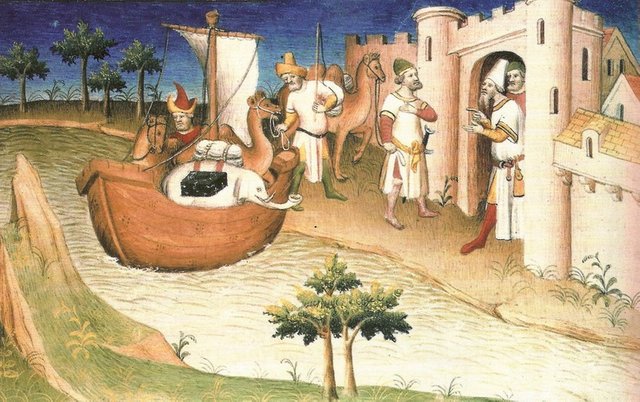
Marco Polo in China (hereinafter referred to as the "Book of the Diversity of Peace" by Marco Polo (1254-1324)
But during the search I tried to figure out when it, this yoke, appeared. No, not when the evil Tatar-Mongols burned their native hut, but when this term appeared.
And it turned out that no one had even heard of the Tatar-Mongolian yoke until the 19th century. While a certain Christopher Cruise in 1817 did not publish " Atlas and tables for viewing the history of all European lands and states from their first population to our times, " where he first introduced the term " Mongol-Tatar yoke " into scientific circulation .
Although, this work was translated into Russian only in 1845, but domestic historians began to use this new scientific definition since 1823. And the first was the famous historian Pyotr Nikolaevich Naumov. True, I did not understand to whom this well-known historian, apparently widely known in narrow circles, was known.
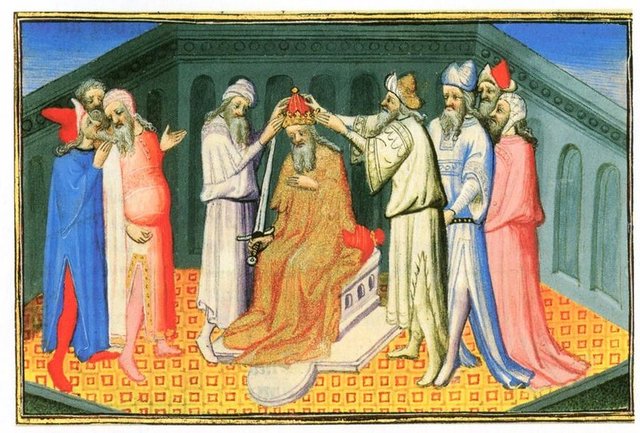
The wedding of Genghis Khan to the kingdom.
It turns out that the Russians learned about the Tatar-Mongol conquest less than two hundred years ago, and from a German historian who lived almost half a thousand years after the events studied.
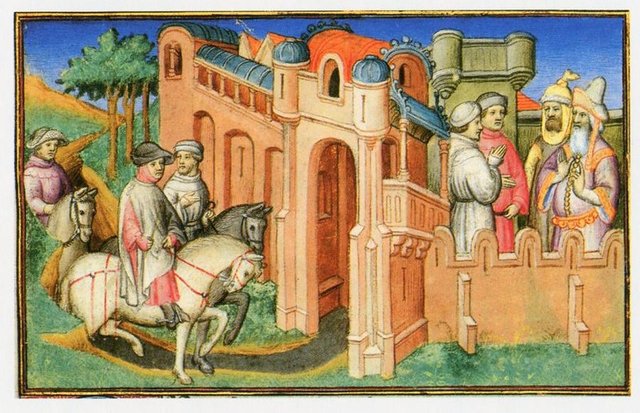
At the gates of the city of Great Khan
Well, in order to be as accurate as possible and fully cover the topic of the origin of this term, mention similar terms.
In 1575, the term "jugo Tartarico" was used in the recording of Daniel Prince about his diplomatic mission to Moscow.
" Ivan Vasilievich, the grandfather of the now reigning, since his relatives from mutual intestine wars have declined tremendously, and he himself also deprived many of his life for blinding his father, then, on the overthrow of the Tartar yoke, having an elevated character, the first called himself" King "( Czarum), which the Moscow princes had never used before."
I will draw attention to the context of mentioning the Tartar yoke " from mutual intestine wars have diminished immensely, and he himself also deprived many of his life ." In this context, it becomes interesting who these Tartars were? Are not they Russian princes?
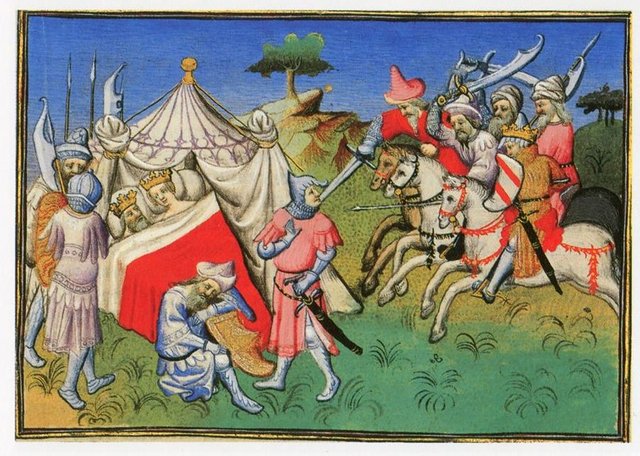
The battle between Great Khan Khubilai (Kubilai) and his uncle Nayan
The term occurs later in the notes about the Moscow war of 1578-1582, compiled by Rheingold Heidenstein, there are references to the English thinker John Milton and the Frenchman De Tu. I will draw attention to the absence of the term "Mongolo" in the term, which is quite important. And the notion of "Tartar yoke" can be interpreted in different ways, because Western Europeans called Tartarus everything that was east of the Holy Roman Empire. And then it's more appropriate to translate it as a "Slavic yoke."
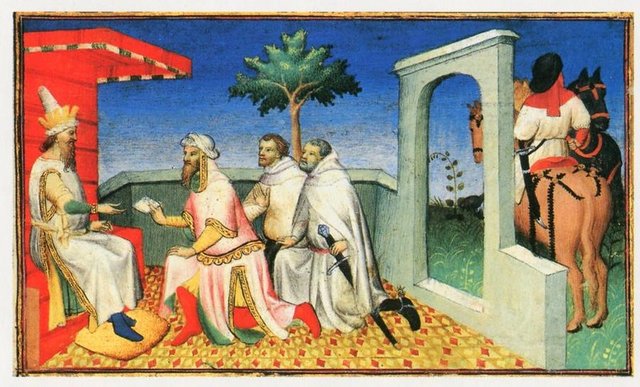
The Great Khan, who receives a letter from the pope.
And this is directly confirmed from the times of TMY itself. The very first mention of the yoke, in general, is the mention of Jan Dlugosch in his "Chronicles of the famous Kingdom of Poland" " iugum barbarum", that is, the "barbaric yoke" or "yoke of the barbarians". A very interesting term from which, by an easy modification, the Tatar-Mongolian yoke turned out. And interestingly, at different times the Europeans called barbarians the totality of peoples who invaded the Roman Empire (barbarian conquests) and founded independent states (kingdoms) on its territory.
Under the totality of peoples are understood different peoples in different historical periods from the first Roman Empire to the Middle Ages, and more specifically in chronological order: - Celts, Germans, Thracians (including Dacians, Getae), Illyrians and Messapes, Scythian-Sarmatian tribes and
Slavic tribes. All these tribes are of Indo-European origin, they have in their gene pool 3 prevailing haplogroups: R1b, I1, R1a, which speaks of a relative affinity for the Slavic group and no relation to the Mongols.
And what do we get as a result? What a yoke existed. But not the Tatar-Mongolian, but in the form of barbarian conquests, that is, the "Slavic yoke" that has lasted permanently for several thousand years. And I would instead use the term "Slavic yoke" to use - "the system of political and economic government of Russian princes over the Roman Empire ."
ZY My daughter on Thursday handed over the OGE on history, so there already in the answers there is a version that the khans are Russian military leaders who led the Russian army - the horde. About how ... A dozen years ago, my interlocutors twisted my statement for such a statement ... Everything flows, everything changes ...
Оригинал: Татаро-монгольское иго-го
Disclaimer: I wanted to make a translation of my posts on history, but I realized that I can not translate it. Difficulties and peculiarities of translations make themselves felt, Nevertheless the text will be in English and the guarantee that it will be understood or understood will not be true, but there will be a link to the Russian version, for those who still want to understand the meaning of the text.
Posts from the HBC (HistoryBlockChain)
HBC: The old pavement and the cosmodrome of Asgard ( part 2 )
HBC: The old pavement and the cosmodrome of Asgard ( part 1)
HBC: The old pavement and the cosmodrome of Asgard (part 0)
HBC: The historical secrets of Omsk or the mysteries of Asgard
HBC: In search of Asgard ... What? Where? When?
And more in #hbc. He writes for you, Eugene. Like? Subscribe!
